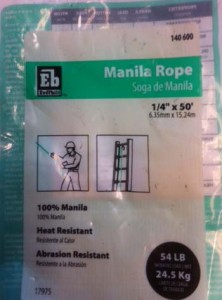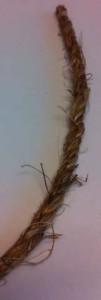
There was a Scout who procured ten 50 feet x 1/4-inch packages of what was presented as 100% manila rope. He wanted to prepare the rope to be used for pioneering projects and set about diligently pre-stretching each 50-foot length, cutting each into various lengths for lashing, painstakingly applying a sailmaker’s whipping to each end, burning off excess hairs because the ropes were very hairy, and then color-coding the tips with a little paint.

Because the rope was so hairy, uneven, and rather stiff, the Scout was concerned that the quality of this manila was pretty poor. But, he persevered in his labors because this is rope he had to work with. During the process of coiling and storing the lashing ropes, he became more and more concerned that this manila must be very old or something, because it was so dry and a whole lot less flexible than the lashing ropes he had used for projects in the past. Wondering if there was something he could treat the rope with to perhaps make it a little more flexible and soft, he set out to get some information from a rope expert. In the process, he contacted a real rope man from Louisiana who’s company distributed rope to bona fide suppliers. After this man learned that the rope was from China, it became very clear, the rope was not manila at all. Instead, it was sisal that had been color-treated to resemble manila. Pure manila rope comes from the Philippines. The man said the rope in question should NEVER have been sold as manila, but instead as “natural fiber” rope!
So, please watch out! Buyer beware! Sisal is not anywhere near as good for projects as manila. There’s a big difference between the two:
Manila rope is from the stems of the abaca plant which grows in the Philippines. (The capital of the Philippines is Manila, and hence the rope’s name.) The stems of the abaca plant have long fibers that make them very well-suited for making rope. Pure manila rope is by far the best all-around rope. Read a description.
Sisal rope, on the other hand, is from a cactus plant that grows in very dry areas and whose fibers are shorter and more splintery. Big difference! Sisal rope has much the same appearance as manila rope, but it is quite inferior in strength and does not handle well when used for lashing or knot tying. When sisal rope that is tied into a knot or lashing gets wet and then dries, it becomes useless because of the kinks that remain.

Even though it costs less. it is not cost effective because it breaks down quickly during use and when it gets wet. It might offer limited use in cases where expendable, but overall the cost is high when compared to other types of rope that can be used again and again.
Please don’t be fooled. As for the poor Scout who went through all the time and effort to prepare new lashing ropes and ended up with forty of lower quality, you gotta love him. And, after 80 applications, at least he’s now an expert at tying the sailmaker’s whipping.